The Lymphatic System - Ailments: what can go wrong with the lymphatic system
By its very nature, the lymphatic system is involved whenever the body is fighting against foreign pathogens or abnormal body cells. The lymph nodes (especially in the neck) often swell with bacteria and lymphocytes when the body is battling common illnesses such as colds and influenza. However, certain diseases and disorders target the lymphatic system. Some slow down the ability of the system to work; others literally shut it down. The result can be life threatening.
The following are a few of the diseases that can impair the lymphatic system or its parts.
AIDS: Acquired immune deficiency syndrome, a disorder caused by a virus (HIV) that infects helper T cells and weakens immune responses.
Allergy (AL-er-jee): An abnormal immune reaction to an otherwise harmless substance.
Autoimmune disease (au-toe-i-MYOON): Condition in which the body produces antibodies that attack and destroy the body's own tissues.
Graves' disease: Disorder in which an antibody binds to specific cells in the thyroid gland, forcing them to secrete excess thyroid hormone.
HIV: Human immunodeficiency virus, which infects helper T cells and weakens immune responses, leading to the severe AIDS disorder.
Lymphadenitis (lim-fad-e-NIE-tis): Inflammation of lymph nodes.
Lymphangitis (lim-fan-JIE-tis): Inflammation of lymphatic vessels.
Lymphoma (lim-FOE-mah): General term applied to cancers of the lymphatic system, which include Hodgkin's lymphoma and non-Hodgkin's lymphomas.
Multiple sclerosis (skle-ROW-sis): Disorder in which immune cells attack and destroy the insulation covering nerve fibers in the central nervous system, causing muscular weakness and loss of coordination.
Systemic lupus erythematosus (sis-TEM-ick LOU-pus er-i-the-mah-TOE-sis): Also called lupus or SLE, disorder in which antibodies attack the body's own tissues as if they were foreign.
Tonsillitis (tahn-si-LIE-tis): Infection and swelling of the tonsils.
Sub-Saharan Africa: 22,500,000
South and Southeast Asia: 6,700,000
Latin America: 1,400,000
North America: 890,000
East Asia and Pacific: 560,000
Western Europe: 500,000
Caribbean: 330,000
Eastern Europe and Central Asia: 270,000
North Africa and Middle East: 210,000
Australia and New Zealand: 12,000
AIDS/HIV
AIDS (acquired immune deficiency syndrome) has been described as the plague of the twentieth century. Since 1981, when it was first recognized in the United States, the disease has claimed almost 14 million lives worldwide. AIDS is currently the leading cause of death among all men between the ages of twenty-five and forty-four. The World Health Organization (a specialized agency of the United Nations) estimates that at the beginning of the twenty-first century, 40 million people worldwide will be infected with HIV, the virus that causes AIDS. Once infected, individuals may not develop symptoms of the disease for as many as ten years or more.
HIV (human immunodeficiency virus) impairs the body's ability to produce an immune response. Specifically, the virus infects helper T cells. Once inside a helper T cell, HIV can replicate or reproduce within the cell and kill it in ways that are still not completely understood. When the newly formed viruses break out of the dying helper T cell, they continue the cycle by infecting other helper T cells. In response, the body produces more helper T cells, but this only provides the virus with more hosts in which to grow and spread.
Because helper T cells play a central role in directing the body's immune response, their destruction brings about a drop in cell-mediated immunity. The number of antibodies produced in the body declines, leaving it without defenses against a wide range of invaders. Many different types of infections and cancers can develop, taking advantage of the body's weakened immune response. These infections, normally harmless when the body is functioning properly, are known as opportunistic infections.
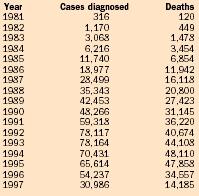
| Year | Cases diagnosed | Deaths |
| 1981 | 316 | 120 |
| 1982 | 1,170 | 449 |
| 1983 | 3,068 | 1,478 |
| 1984 | 6,216 | 3,454 |
| 1985 | 11,740 | 6,854 |
| 1986 | 18,977 | 11,942 |
| 1987 | 28,499 | 16,118 |
| 1988 | 35,343 | 20,800 |
| 1989 | 42,453 | 27,423 |
| 1990 | 48,266 | 31,145 |
| 1991 | 59,318 | 36,220 |
| 1992 | 78,117 | 40,674 |
| 1993 | 78,164 | 44,108 |
| 1994 | 70,431 | 48,110 |
| 1995 | 65,614 | 47,858 |
| 1996 | 54,237 | 34,557 |
| 1997 | 30,986 | 14,185 |
People living with HIV/AIDS: 33.4 million
New HIV infections in 1998: 5.8 million
Deaths due to HIV/AIDS in 1998: 2.5 million
Total number of deaths due to HIV/AIDS: 13.9 million
HIV is transmitted between humans in blood, semen, and vaginal secretions. The two main ways to contract the virus are by sharing a needle with a drug user who is HIV-positive or by having unprotected sexual relations with a person who is HIV-positive. (A person who is HIV-positive is already infected with the virus.) It is possible for a pregnant woman who is HIV-positive to transfer the virus to the fetus in her womb. A few individuals have become infected with the virus after receiving a transfusion of contaminated blood.
HIV cannot be transferred through insect bites or stings nor through shaking hands or hugging. No one can contract the virus by sharing telephones or eating utensils, by drinking out of public water fountains, or by swimming in public pools.
There is currently no cure for the disease and no vaccine to prevent its spread. The best defense against AIDS is avoiding sexual contact with infected individuals. Intravenous drug use (injecting drugs into the bloodstream) of any kind should always be avoided. Several antiviral drugs have been developed that slow the progress of the disease in infected individuals. Combinations of these drugs—known informally as cocktails—have proven effective in improving the quality and length of life of AIDS patients, especially those who have been diagnosed in the early stages of the disease.
Medical research findings released in April 1999, however, have shown that the virus can "hide" in memory T cells for up to sixty years. When called upon to fight an infection, such as influenza, the memory T cells could flood an individual's system with HIV.
Allergies
An allergy is an abnormal immune reaction to an otherwise harmless substance. Among the most common of medical disorders, allergies affect an estimated 60 million Americans, or more than one in every five people.
Normally, when a foreign microorganism enters the body, antibodies are produced to bind to the antigens on the foreign particles, and a series of immune reactions take place. When harmless, everyday substances cause the same series of immune reactions, the condition is known as allergy. The offending substance is called an allergen.
Common allergens abound. People may react to airborne particles (plant pollens, animal fur, house dust, cigarette smoke), food (nuts, eggs, fish, milk), drugs (penicillin or other antibiotics), insect bites (bees, wasps, mosquitoes, fleas), or even materials (wool and latex).
Symptoms depend on the specific type of allergic reaction. In the most common type of reaction, antibodies stimulated by the allergen cause certain cells to release histamine into the surrounding interstitial fluid. Histamine causes small blood vessels in the area to expand and become "leaky." Excess fluid and mucus develop, and the common symptoms appear: a runny nose, a scratchy or irritated throat, and red, watery eyes. Allergens that cause a reaction on the skin produce reddened, itchy skin. Those that affect the digestive tract may cause a swelling or tingling in the lips or throat, nausea, cramping, or diarrhea. Most reactions begin within seconds after contact with the allergen and last about half an hour. Some may last from one to several hours after contact.
A large number of prescriptions and over-the-counter drugs can treat the symptoms of allergies. Antihistamines, decongestants, and nasal sprays can all be used to decrease or counteract the effect of histamines. Lotions and creams to reduce skin inflammation caused by allergens are also available.
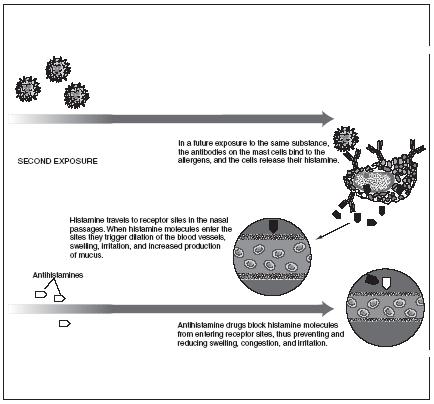
Avoiding allergens is the best way to limit allergic reactions. This is especially true for food allergies. Learning to recognize and avoid those items that produce an allergic reaction allows most people with allergies to lead normal lives.
Autoimmune diseases
Autoimmune diseases are those in which the body produces antibodies and T cells that attack and damage the body's own normal cells, causing tissue destruction. It is a puzzling phenomenon. The reaction can either take place in a number of tissues at the same time or in a single organ. The following are just a few of the many types of autoimmune diseases.
Graves' disease, also called hyperthyroidism, occurs when an antibody binds to specific cells in the thyroid gland, forcing them to secrete excess thyroid hormone. Symptoms of the condition include weight loss with increased appetite, shortness of breath, tiredness, weak muscles, anxiety, and visible enlargement
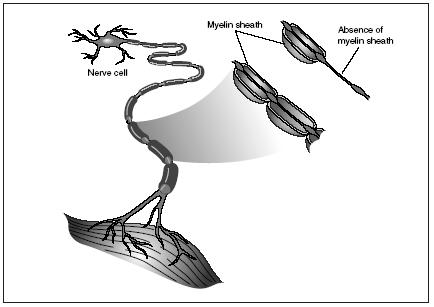
of the thyroid gland. Treatments include drugs to stop the hormone production, radioactive iodine to destroy the hormone-producing cells and shrink the enlarged gland, and surgery to remove a part or all of the thyroid.
Multiple sclerosis (MS) is a disease in which immune cells attack and destroy the insulation covering nerve fibers (neurons) in the central nervous system (brain and spinal cord). Once the insulation, called myelin, is destroyed, nerve messages are sent more slowly and less efficiently. As a result, the brain and spinal cord no longer communicate properly with the rest of the body. When this occurs, vision, balance, strength, sensation, coordination, and other bodily functions all suffer. More than 250,000 people in the United States are afflicted with MS. Women are twice as likely to get the disease as men. Drugs have been developed that slow the progress of the disease in many patients, but no cure has yet been found.
Systemic lupus erythematosus (also called lupus or SLE) is a disease in which antibodies begin to attack the body's own tissues and organs as if they
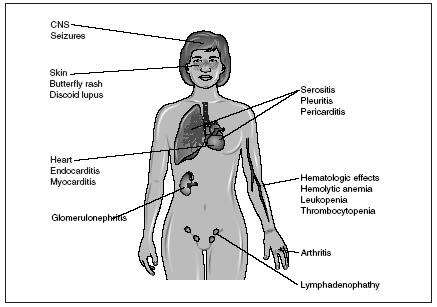
were foreign. The cause of SLE is unknown. It can affect both men and women of all ages, but 90 percent of those afflicted are women. Among the many symptoms of the disease are fevers, weakness, muscle pain, weight loss, skin rashes, joint pain, headaches, vomiting, diarrhea, and inflammation of the lining of the lungs or the lining around the heart. Treatment for SLE depends on how severe the symptoms are. Mild symptoms like inflammation can be treated with aspirin or ibuprofen. Severe symptoms are often treated with stronger drugs, including steroids. Drugs to decrease the body's immune response may also be used for severely ill SLE patients.
Lymphadenitis
Lymphadenitis is the inflammation of lymph nodes. The cause is often an infection of the nodes by bacteria that has entered through a cut or wound in the skin. A virus may also be the cause. The infection may occur in a limited number of nodes in a specific area or in many nodes over a wider area. If the lymph vessels connecting the affected nodes are also inflamed, that condition is known as lymphangitis.
The swollen nodes are often painful to the touch. The skin over the nodes may also be red and warm to the touch. If the accompanying lymph vessels are involved in the infection, they will appear as red streaks from the wound to the lymph nodes. In children, the swollen nodes often appear in the neck because they are close to the ears and throat—locations of frequent bacterial infections in children.
Treatment for lymphadenitis and lymphangitis usually involves medications. Antibiotics, such as penicillin, are often prescribed, and the infection is brought under control in three to four days. If left untreated, the infection may lead to blood poisoning, which is sometimes fatal.
Lymphoma
Lymphoma is a type of cancer in which cells of the lymphatic system (B cells and T cells) become abnormal and begin to grow uncontrollably. Because lymphatic tissue is found throughout the body, lymphomas can occur anywhere. There are many types of lymphomas, but they are generally divided into two main groups: Hodgkin's lymphoma and non-Hodgkin's lymphomas. The exact cause of the cancers in either group is not known.
Hodgkin's lymphoma (or Hodgkin's disease) can occur at any age, although people in early adulthood (ages fifteen to thirty-four) and late adulthood (after age sixty) are most affected. The cancer begins in a lymph node (usually in the neck), causing swelling and possibly pain. After affecting one group of nodes, it progresses on to the next. In advanced cases of the cancer, the spleen, liver, and bone marrow may also be affected. Symptoms
include fatigue, weight loss, night sweats, and itching. As the cancer spreads throughout the body, the immune response becomes less effective. Common infections caused by bacteria and viruses begin to take over.
Hodgkin's lymphoma is one of the most curable forms of cancer. However, as with any form of cancer, early detection and treatment is highly recommended. Once detected in the body, Hodgkin's is usually treated through chemotherapy (using a combination of drugs to kill the cancer cells and shrink any tumors) or radiation therapy (using X rays or other high-energy rays to kill the cancer cells and shrink any tumors) or a combination of both.
Non-Hodgkin's lymphomas encompass over twenty-nine types of lymphomas. Again, the exact cause of these lymphomas is unknown. In general,
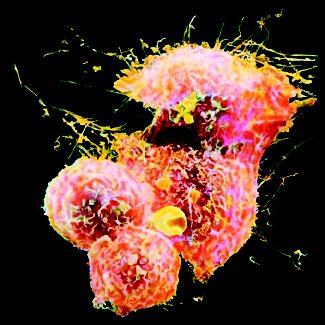
males suffer from these cancers more than females. People between the ages of sixty and sixty-nine are at the highest risk of contracting these lymphomas. Non-Hodgkin's lymphomas also tend to strike people suffering from AIDS. Symptoms for non-Hodgkin's lymphomas are similar those for Hodgkin's lymphoma. Along with the swelling of lymph nodes, patients may experience loss of appetite, weight loss, nausea, vomiting, pain in the lower back, headaches, fevers, and night sweats. The liver and spleen may enlarge, as well. Immune responses may be weakened.
Treatment for non-Hodgkin's lymphomas also include chemotherapy and radiation therapy (either by themselves or in combination). In severe cases, bone marrow transplants may take place. Since the "cure" rate for non-Hodgkin's lymphomas is not as good as it is for Hodgkin's lymphoma, early detection and treatment is vital.
Tonsillitis
Tonsillitis is an infection and swelling of the tonsils. The condition is caused by bacteria or viruses that have entered the body through the mouth or sinuses. In addition to swollen and red tonsils, symptoms include a mild or severe sore throat, fever, chills, muscle aches, earaches, and tiredness. Although anyone can be afflicted with tonsillitis, the disease is most common in children between the ages of five and ten.
For mild cases of tonsillitis, treatment usually involves bed rest and drinking extra fluids. The body usually brings the infection under control within a few days. If the case is more severe, penicillin or other antibiotics may be prescribed to combat the infection. If an individual suffers repeatedly from
severe tonsillitis, the tonsils may be removed surgically. That procedure is called a tonsillectomy.

Comment about this article, ask questions, or add new information about this topic: